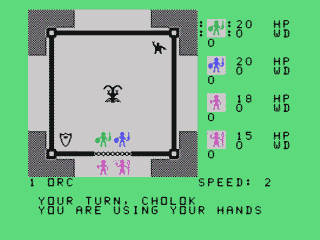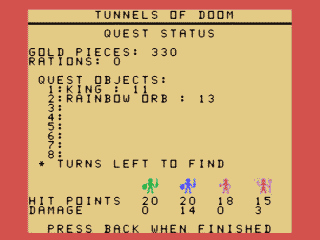Retro Replay Review
Gameplay
Tunnels of Doom delivers a surprisingly deep and engaging gameplay loop considering its early place in CRPG history. You control a party of up to four characters—each drawn from the classic archetypes of Fighter, Rogue, Wizard, and the special solo-only Hero—navigating grid-based corridors teeming with traps, monsters, and hidden treasure. The ability to switch between party-wide commands and individual actions keeps each dungeon dive fresh and strategic.
(HEY YOU!! We hope you enjoy! We try not to run ads. So basically, this is a very expensive hobby running this site. Please consider joining us for updates, forums, and more. Network w/ us to make some cash or friends while retro gaming, and you can win some free retro games for posting. Okay, carry on 👍)
Combat is turn-based and unfolds on a side-view battle screen, where positioning and class synergy truly shine. Fighters draw enemy aggro and deal steady damage, Rogues slip past defences for critical strikes, Wizards unleash area spells at the cost of fragile hit points, and the lone Hero single-handedly balances offense and defence. Whether you assign turns as a single player or coordinate tactics in a multiplayer session, every battle feels alive with opportunity and risk.
Exploration is equally rewarding: random encounters ensure that no two corridors feel the same, while scattered fountains offer unpredictable buffs—or curses—for those brave (or unlucky) enough to drink. Treasure chests are stuffed with gold, potions, and rare artifacts, and you’ll regularly return to town to buy improved weapons and armor, making each return trip a welcome respite and planning session before plunging back into the labyrinth.
Despite its straightforward interface, Tunnels of Doom encourages careful resource management. Torches burn down, hit points evaporate, and spell slots run dry, forcing you to weigh every move. Do you press forward in search of more loot, or retreat to restock and heal? This delicate dance between greed and caution underpins the entire gameplay experience and remains compelling even decades after its release.
Graphics
For a game released in the early 1980s, Tunnels of Doom’s visuals are remarkably clear and expressive. The top-down dungeon map uses simple yet functional tiles that convey walls, doors, and secret passages with minimal fuss. Character and monster sprites on the battle screen are basic by today’s standards, but their distinct silhouettes and color use make it easy to tell friend from foe at a glance.
The color palette is limited, yet each element—stone walls, wooden doors, and treasure chests—has its own identifiable look. In dimly lit corridors, the flicker of your torch icon heightens the sense of danger, even if the lighting effects are purely symbolic. It’s an exercise in minimalist design that prioritizes clarity over flash, ensuring that gameplay mechanics remain front and center.
Animation frames are sparse, but purposeful. A swinging sword, a wizard’s flash of light, or a Rogue’s crouched back‐stab pose all register with satisfying clarity. Monsters lumber into view, cast spells, and fall with just enough movement to feel dynamic. While modern gamers might scoff at the simplicity, there’s a charming nostalgia in these pixel-perfect actions that captures the spirit of early home computing.
Overall, the graphics serve the game’s core functions beautifully. They guide you through the dungeon, illustrate combat outcomes, and highlight important environmental features without ever overwhelming the player. In that sense, Tunnels of Doom stands as an early example of how form can follow function in game design.
Story
Tunnels of Doom isn’t driven by an elaborate plot or sprawling narrative—its story is one of classic dungeon exploration and treasure hunting. You assume the role of adventurers hired to clear the mysterious tunnels beneath the land, rooting out monsters and retrieving lost artifacts. This bare-bones premise provides enough context for your quests without bogging down the action in lengthy exposition.
That said, the game’s minimal storytelling offers plenty of room for player imagination. As you descend deeper, each level feels progressively more dangerous and atmospheric, hinting at an unseen presence lurking in the darkness. Random encounter descriptions and item names contribute snippets of lore, encouraging you to piece together the dungeon’s history on your own terms.
If narrative is what you crave, you might find Tunnels of Doom light on cutscenes or dialogue. However, the emergent stories born of narrow escapes, critical spell‐casting moments, and surprise ambushes create memorable vignettes. Friends who tackled dungeons together often recall particular battles or near-deaths more vividly than any scripted plot twist.
In essence, the story functions as a framework for your adventures. It’s a testament to early RPG design: trust the player’s creativity to fill in the gaps with personal anecdotes and in-game legend, resulting in tales told around the digital campfire long after the final monster falls.
Overall Experience
Playing Tunnels of Doom today is like stepping back into the dawn of computer role-playing. It marries straightforward mechanics with enough strategic depth to keep you invested for hours. Whether you’re a solo tinker experimenting with different class compositions or coordinating tactics with friends, the core loop of explore, fight, loot, and upgrade remains endlessly satisfying.
Its learning curve is gentle but firm: you’ll make plenty of mistakes with wasted spells or misjudged encounters, yet each setback teaches you something new. The thrill of finding a hidden fountain (and nervously sipping from it) or dispatching a troll with a well-timed Fireball spell never gets old. There’s a real sense of accomplishment when your party survives to see the next level of the dungeon.
While it lacks modern conveniences like quest logs or detailed NPC interactions, those omissions also clear the way for pure dungeon-crawling fun. You aren’t distracted by side quests or elaborate character backstories—your only mission is to conquer the Tunnels, one dark corridor at a time. In that laser focus lies its enduring charm.
For fans of vintage RPGs or anyone curious about the genre’s origins, Tunnels of Doom offers both historical significance and genuine entertainment. It may not astonish with photorealistic visuals or voice acting, but its tight gameplay, minimalist design, and cooperative possibilities make it a must-try for nostalgic explorers and modern adventurers alike.
 Retro Replay Retro Replay gaming reviews, news, emulation, geek stuff and more!
Retro Replay Retro Replay gaming reviews, news, emulation, geek stuff and more!









Reviews
There are no reviews yet.